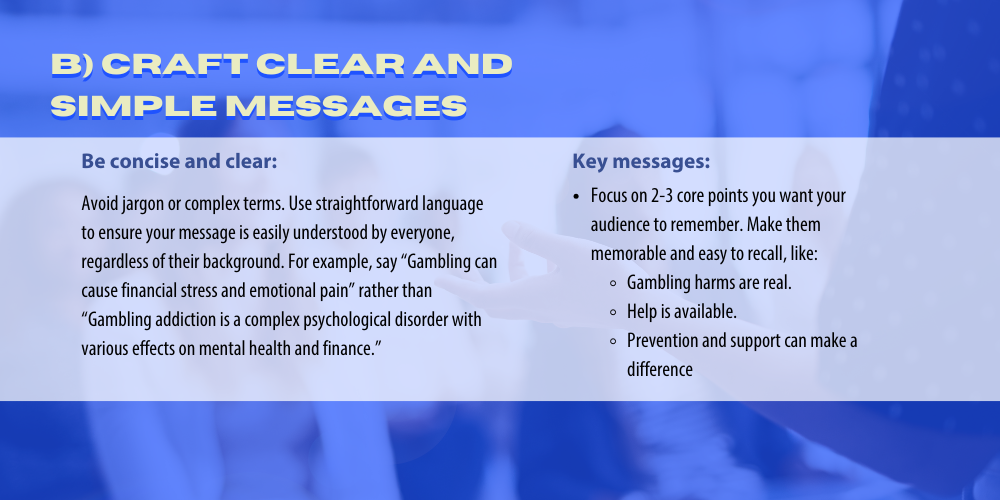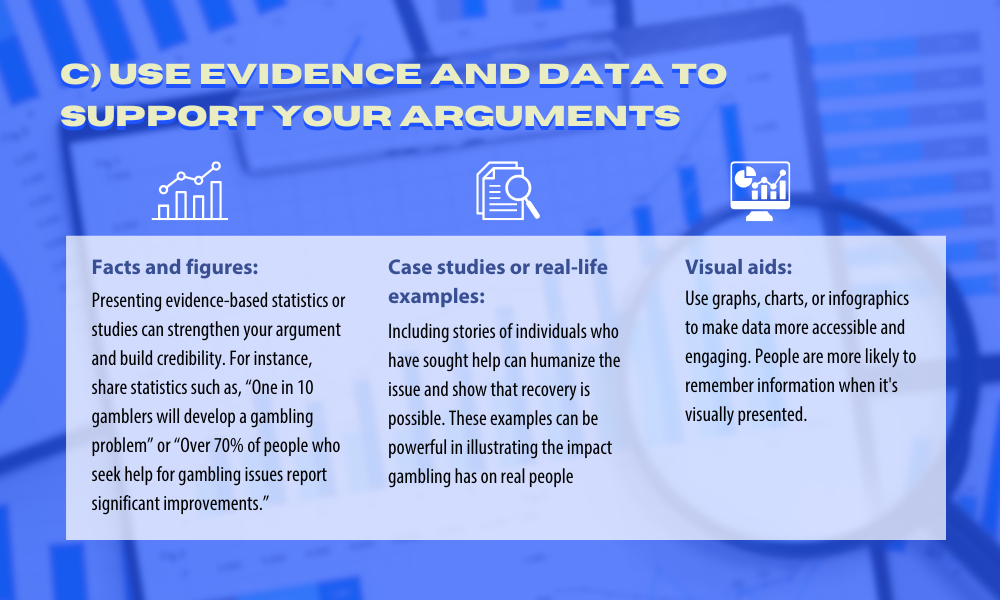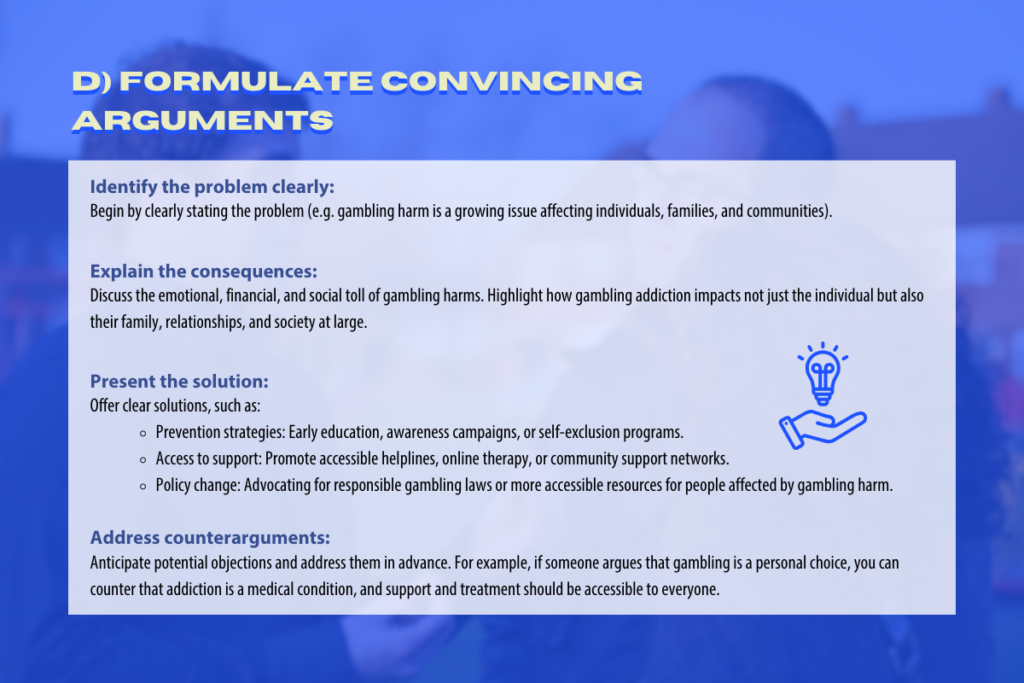Effective communication is essential in gambling harm prevention, especially when trying to educate, raise awareness, and motivate people to seek help. Whether you’re speaking with individuals who may be struggling with gambling or advocating for policies to address gambling harms, your ability to convey your ideas clearly and persuasively is critical. Here are some communication strategies to consider, focusing on how to put your ideas forward and formulate convincing arguments:
a) Know Your Audience

- Tailor your message: Understanding the background, experiences, and emotions of your audience helps you craft a message that resonates with them. For example, when talking to those struggling with gambling, you might focus on the emotional and financial toll it takes. When addressing the general public, you may want to focus more on the societal impact and the importance of awareness.
- Empathy and non-judgmental approach: In conversations about sensitive topics like gambling harm, approach with empathy and avoid judgment. Use language that invites understanding, such as “If you’re struggling with gambling…” instead of “You’re addicted to gambling…”
b) Craft Clear and Simple Messages

- Be concise and clear: Avoid jargon or complex terms. Use straightforward language to ensure your message is easily understood by everyone, regardless of their background. For example, say “Gambling can cause financial stress and emotional pain” rather than “Gambling addiction is a complex psychological disorder with various effects on mental health and finance.”
- Key messages: Focus on 2-3 core points you want your audience to remember. Make them memorable and easy to recall, like:
- Gambling harms are real.
- Help is available.
- Prevention and support can make a differenceare real
c) Use Evidence and Data to Support Your Arguments

- Facts and figures: Presenting evidence-based statistics or studies can strengthen your argument and build credibility. For instance, share statistics such as, “One in 10 gamblers will develop a gambling problem” or “Over 70% of people who seek help for gambling issues report significant improvements.”
- Case studies or real-life examples: Including stories of individuals who have sought help can humanize the issue and show that recovery is possible. These examples can be powerful in illustrating the impact gambling has on real people
- Visual aids: Use graphs, charts, or infographics to make data more accessible and engaging. People are more likely to remember information when it’s visually presented.
d) Formulate Convincing Arguments

- Identify the problem clearly: Begin by clearly stating the problem (e.g., gambling harm is a growing issue affecting individuals, families, and communities).
- Explain the consequences: Discuss the emotional, financial, and social toll of gambling harms. Highlight how gambling addiction impacts not just the individual but also their family, relationships, and society at large.
- Present the solution: Offer clear solutions, such as:
- Prevention strategies: Early education, awareness campaigns, or self-exclusion programs.
- Access to support: Promote accessible helplines, online therapy, or community support networks.
- Policy change: Advocating for responsible gambling laws or more accessible resources for people affected by gambling harm.
- Address counterarguments: Anticipate potential objections and address them in advance. For example, if someone argues that gambling is a personal choice, you can counter that addiction is a medical condition, and support and treatment should be accessible to everyone.
e) Use Persuasive Techniques

- Appeal to emotions: Emotionally engaging language can help people connect with the issue on a deeper level. For example, “Think about a parent who loses everything they have—there’s hope for change with the right support.”
- Ethos (credibility): Build trust by referencing credible sources, such as reputable organizations (e.g., GamCare, Gambling Therapy) and experts in addiction or mental health.
- Pathos (emotion): Evoke emotions by telling a personal story or using powerful visuals. “Sarah was once a compulsive gambler, but after seeking help, she’s now on the road to recovery and rebuilding her life.”
- Logos (logic): Use facts and logical arguments. “Research shows that self-exclusion programs can reduce gambling behavior by 40% in participants.”
f) Encourage Active Listening

- Ask open-ended questions: Encourage the person to share their thoughts or feelings on gambling harm. For example, “What’s your experience with gambling, and how has it affected you or people you know?”
- Validate their concerns: If someone expresses reluctance or skepticism, validate their feelings. “I understand this might be difficult to accept, but there is help out there, and recovery is possible.”
- Be patient and open-minded: Allow people time to process and respond to your arguments, and be ready to clarify or elaborate as needed.
g) Leverage the Power of Positive Messaging

- Hopeful messages: While it’s crucial to highlight the severity of gambling harm, emphasize recovery and hope. Remind people that help is available and that positive change is possible.
- Focus on strengths: For example, “If you’ve taken the step to seek out more information today, you’re already on the path toward making a positive change.”
h) Avoid Stigmatizing Language

- Use neutral language: Instead of labeling someone as a ”gambler” or ”addict,” use terms like “someone affected by gambling” or “individuals with gambling problems.” This helps reduce stigma and encourages people to seek help without feeling judged.
- Frame gambling as a public health issue: Discuss gambling harms in terms of health, much like substance abuse or mental health disorders. This approach helps remove the shame associated with addiction and emphasizes the need for compassion.
i) Be Prepared for Resistance

- Stay calm and respectful: Not everyone will be immediately receptive to the idea of gambling harm prevention. If you encounter resistance, remain respectful and non-confrontational. Focus on building a rapport first, and gently reinforce your message.
- Acknowledge skepticism: Recognize that some people may not believe that gambling addiction is a real problem. Gently guide them toward understanding by highlighting the seriousness of the issue and providing facts or expert opinions.
j) Call to Action (CTA)

- Always end with a clear call to action, whether it’s encouraging someone to seek help, share the message, or learn more about gambling prevention.
- “If you or someone you know is struggling with gambling, don’t wait—call the helpline today.”
- “Join us in spreading awareness about gambling harm prevention by sharing this message.”
Conclusion
To communicate effectively in gambling harm prevention, it’s essential to approach conversations with empathy, use clear language, and present both the emotional and factual aspects of the issue. Craft compelling arguments by focusing on the problem, the consequences, and the solutions, and always include a positive message that recovery is possible. Using a combination of emotional, logical, and ethical persuasion, you can convince others to recognize the importance of gambling harm prevention and take action to support those affected.